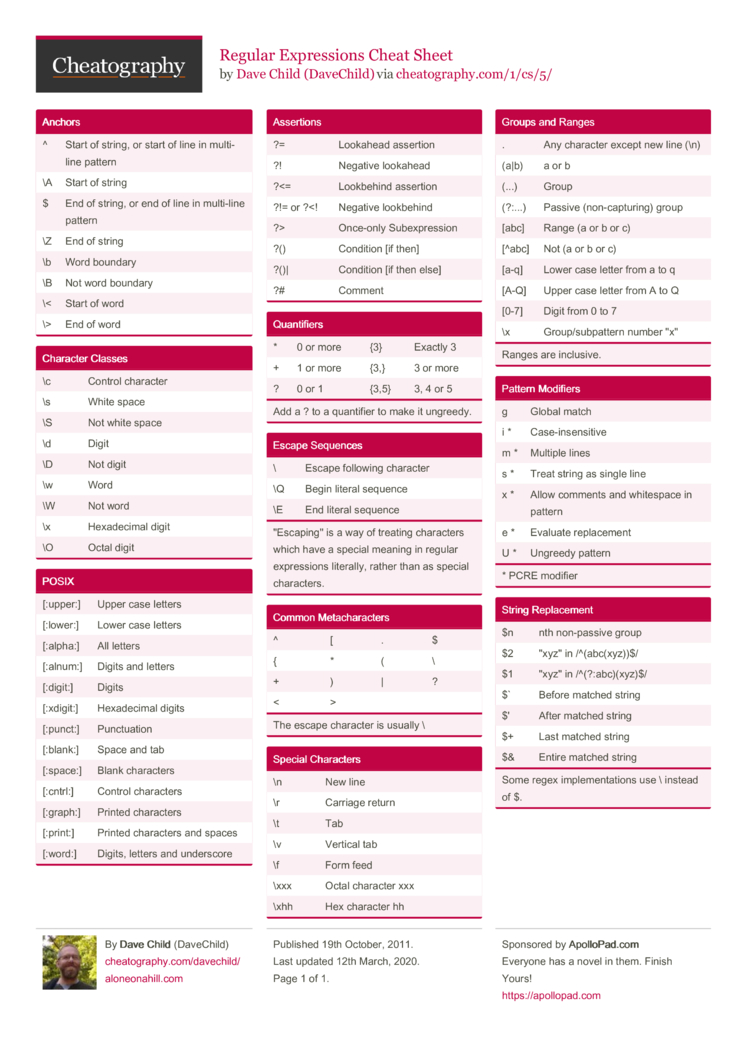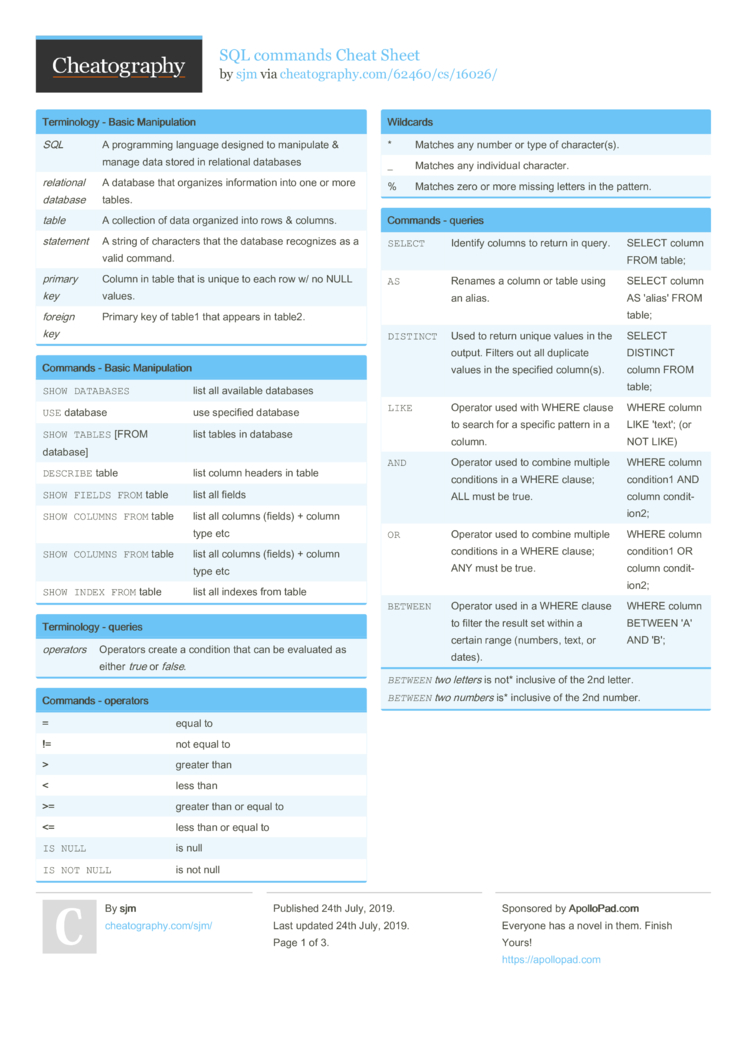MySQL cheat sheet provides you with one-page that contains the most commonly used MySQL commands and statements that help you work with MySQL more effectively. MySQL command-line client Commands Connect to MySQL server using mysql command-line client with a username and password (MySQL will prompt for a password): mysql -u username -p. SQL commands Cheat Sheet. MySQL prior to version 8.0 doesn't support the WITH clause. WITH previ ous Que ryA lias AS ( SEL ECT column1, COU NT( col umn 2) AS. (My)SQL Cheat Sheet Here are the most commonly used SQL commands and the most commonly used options for each. There are many more commands and options than listed here. In other words, the syntaxes as I have listed them are far from complete. See the links at the bottom for more complete syntaxes and more commands.
- Mysql Query Commands Cheat Sheet
- Cheat Sheet Synonyms
- Cheat Sheet Recipes
- Mysql Commands Cheat Sheet
- Mysql Command Line Cheat Sheet Pdf
The SQL cheat sheet provides you with the most commonly used SQL statements for your reference. You can download the SQL cheat sheet as follows:
Querying data from a table
Query data in columns c1, c2 from a table
Query all rows and columns from a table
Query data and filter rows with a condition
Query distinct rows from a table
Sort the result set in ascending or descending order
Skip offset of rows and return the next n rows
Group rows using an aggregate function
Filter groups using HAVING clause

Querying from multiple tables
Inner join t1 and t2
Left join t1 and t1
Right join t1 and t2
Perform full outer join
Produce a Cartesian product of rows in tables
Another way to perform cross join
Join t1 to itself using INNER JOIN clause
Using SQL Operators
Combine rows from two queries
Return the intersection of two queries
Subtract a result set from another result set
Query rows using pattern matching %, _
Query rows in a list
Query rows between two values
Check if values in a table is NULL or not
Managing tables
Create a new table with three columns
Delete the table from the database
Add a new column to the table
Drop column c from the table
Add a constraint
Drop a constraint
Rename a table from t1 to t2
Rename column c1 to c2
Remove all data in a table
Using SQL constraints
Set c1 and c2 as a primary key
Set c2 column as a foreign key
Make the values in c1 and c2 unique
Ensure c1 > 0 and values in c1 >= c2
Set values in c2 column not NULL
Modifying Data
Insert one row into a table
Insert multiple rows into a table
Insert rows from t2 into t1
Update new value in the column c1 for all rows
Update values in the column c1, c2 that match the condition
Delete all data in a table
Delete subset of rows in a table
Managing Views
Create a new view that consists of c1 and c2
Create a new view with check option
Create a recursive view
Create a temporary view
Delete a view
Managing indexes
Create an index on c1 and c2 of the t table
Create a unique index on c3, c4 of the t table

Drop an index
Managing triggers
Create or modify a trigger
WHEN
- BEFORE – invoke before the event occurs
- AFTER – invoke after the event occurs
EVENT
- INSERT – invoke for INSERT
- UPDATE – invoke for UPDATE
- DELETE – invoke for DELETE
TRIGGER_TYPE
- FOR EACH ROW
- FOR EACH STATEMENT
Delete a specific trigger
CLI
Log in as root (password is prompted):
Log in as root with password
sekrit(REMARK: no space allowed between-pand the password):Log in as
useron anotherhost, and use databasemydb(password is prompted):Setting the root password (after clean install):
Queries
First log in as root and use the mysql database: mysql -uroot -p mysql (password is prompted). Don’t forget that every query must be terminated with ;

In the overview below, CAPITALIZED words are part of the SQL syntax, lowercase words are names of tables, columns, etc.
| Task | Query |
|---|---|
| List databases | SHOW DATABASES; |
| Change active database | USE dbname; |
| Change to the “system” database | USE mysql; |
| Show tables in active database | SHOW TABLES; |
| Show table properties | DESCRIBE tablename; |
| List all users | SELECT user,host,password FROM mysql.user; |
| List databases | SELECT host,db,user FROM mysql.db; |
| Quit | exit or Ctrl-D |

Secure installation
Most HOWTOs suggest to run the mysql_secure_installation script after installing MariaDB/MySQL. Since that is an interactive script that constantly asks for user input, it is not suitable for automated setups. There are quick-and-dirty solutions by using either expect or a here document, but these feel kludgy to me.
What happens in the script is basically setting the database root password and removing a test database and users.
Setting the root password
The following snippet will set the database root password if it wasn’t set before, and will do nothing if it was. The command mysqladmin -u root status will succeed if the password was not set, and in that case the password will be set to the specified value.
This code snippet is idempotent, i.e. you can run it several times with the same end result and without it failing if a root password was set previously.
Removing test database and users
Mysql Query Commands Cheat Sheet
After setting the root password with the previous code, the following snippet will remove the test database and anonymous users. The database root user is set to only be allowed to log in from localhost.
Create a new database and user
Cheat Sheet Synonyms
Create a database and a user with all privileges for that database (warning: user/db are first removed if they exist):
Cheat Sheet Recipes
Backup/restore
Mysql Commands Cheat Sheet
Let’s say you have a Drupal site that you want to back up/restore. The database is drupal.
Mysql Command Line Cheat Sheet Pdf
- Backup:
mysqldump -u root -p drupal > drupal_backup.sql - Restore:
- First, ensure that the
drupaldatabase exists (see above) mysql -u root -p drupal < drupal_backup.sql
- First, ensure that the
